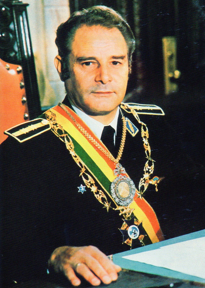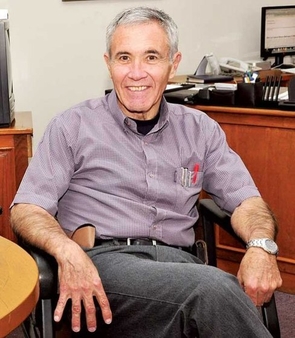
Hugo Banzer Suárez was a Bolivian politician and military officer who served as the 51st president of Bolivia. He held the Bolivian presidency twice: from 1971 to 1978 as a military dictator; and then again from 1997 to 2001, as a democratically elected president.

The Revolutionary Nationalist Movement is a centre-right, conservative political party in Bolivia. It was the leading force behind the Bolivian National Revolution from 1952 to 1964. It influenced much of the country's history since 1941.

Ángel Víctor Paz Estenssoro was a Bolivian politician who served as the 45th president of Bolivia for three nonconsecutive and four total terms from 1952 to 1956, 1960 to 1964 and 1985 to 1989. He ran for president eight times and was victorious in 1951, 1960, 1964 and 1985. His 1951 victory was annulled by a military junta led by Hugo Ballivián, and his 1964 victory was interrupted by the 1964 Bolivian coup d'état.

Hernán Siles Zuazo was a Bolivian politician who served as the 46th president of Bolivia twice nonconsecutively from 1956 to 1960 and from 1982 to 1985. He also briefly served as interim president in April 1952, and as the 27th vice president of Bolivia from 1952 to 1956.

Juan José Torres González was a Bolivian socialist politician and military leader who served as the 50th president of Bolivia from 1970 to 1971, when he was ousted in a coup that resulted in the dictatorship of Hugo Banzer. He was popularly known as "J.J." (Jota-Jota). Juan José Torres was murdered in 1976 in Buenos Aires, in the frame of the United States-backed campaign Operation Condor.

The Bolivian Socialist Falange is a Bolivian political party established in 1937. It is a far-right party drawing inspiration from fascism. It was the country's second-largest party between approximately 1954 and 1974. After that, its followers have tended to gravitate toward the government-endorsed military candidacy of General Juan Pereda (1978) and, especially, toward the ADN party of former dictator Hugo Banzer.

Juan Pereda Asbún was a Bolivian military general who served as the de facto 52nd president of Bolivia in 1978. Although he ruled for only four months, his ascent to the presidency marked the beginning of the most unstable period in Bolivian history, with nine presidents in a little over 4 years (1978–1982), in comparison to only one in the previous seven.
The history of Bolivia involves thousands of years of human habitation.
Bolivia's defeat by Paraguay in the Chaco War of 1932–1936 marked a turning point in the modern history of Bolivia. Great loss of life and territory discredited the traditional ruling classes, while service in the army produced stirrings of political awareness among the indigenous people. A large portion of the contested Gran Chaco region was surrendered to Paraguay. In return Bolivia was given access to the Paraguay River where Puerto Busch was founded and, with this, free access to the Atlantic Ocean through international waters was possible. In 1936 Standard Oil's Bolivian operations were nationalized and the state-owned firm Yacimientos Petroliferos Fiscales Bolivianos (YPFB) was created. From the end of the Chaco War until the 1952 Bolivian National Revolution, the emergence of contending ideologies and the demands of new groups convulsed Bolivian politics.

The history of Bolivia from 1964 to 1982 is a time of periodic instability under various military dictators. On November 4, 1964, power passed from the elected leader of the Bolivian National Revolution, Víctor Paz Estenssoro to a military junta under vice-president General René Barrientos. Barrientos was elected president in 1966, but died suspiciously in a helicopter crash in 1969 while touring the countryside visiting the indigenous people of Bolivia. This led to a coup in September 1969 by General Ovando, who was overthrown in October 1970 by General Rogelio Miranda who was overthrown a couple of days later by General Juan José Torres, who in turn was overthrown in August 1971 by Hugo Banzer Suárez. Banzer ruled for seven years, initially from 1971 to 1974 with the support of Estenssoro's Nationalist Revolutionary Movement. In 1974, impatient with schisms in the party, he replaced civilians with members of the armed forces and suspended political activities. The economy grew impressively during Banzer's presidency, but demands for greater political freedom undercut his support. He called elections in 1978 and Bolivia once again plunged into turmoil. Juan Pereda ruled for only four months in 1978, but his ascent to the presidency marked the beginning of an even more unstable period in Bolivian history, with nine civilian and military presidents in little over four years (1978–1982). 1982 marked the return to a democratically elected government, with Guido Vildoso as president.

General elections were held in Bolivia on 6 June 1993. As no candidate for the presidency received over 50% of the vote, the National Congress was required to elect a president on 4 August. Gonzalo Sánchez de Lozada of the MNR-MRTKL alliance was subsequently elected unopposed.

General elections were held in Bolivia on 1 July 1979. As no candidate in the presidential elections received a majority of the vote, the National Congress was required to elect a President. However, the Congress failed to elect a candidate after three ballots and instead selected Senate leader Wálter Guevara to serve as Interim President for a year on 8 August. Guevara was later overthrown by a military coup led by Alberto Natusch on 31 October. Fresh elections were held in June 1980.

General elections were held in Bolivia on 29 June 1980, the third in three years. As no candidate in the presidential elections received a majority of the vote, the National Congress was required to elect a President on 6 August. With Hernán Siles Zuazo of the Democratic and Popular Union the favourite to win the Congressional ballot, the process was disrupted on 17 July by the military coup led by General Luis García Meza Tejada. However, Meza was pressured to resign on 4 August 1981, resulting in General Celso Torrelio becoming president. In July 1982 he was replaced by General Guido Vildoso, who was named by the high command to return the country to democratic rule. On 17 September 1982, during a general strike that brought the country close to civil war, the military decided to step down, to reconvene the National Congress elected in 1980, and to accept its choice of president. Accordingly, the National Congress revalidated the 1980 election results on 23 September and overwhelmingly elected Hernán Siles Zuazo as president on 5 October. He subsequently assumed the presidency on 10 October 1982.

General elections were held in Bolivia on 14 July 1985. As no candidate for the presidency received over 50% of the vote, the National Congress was required to elect a President on 4 August. Although Hugo Banzer of Nationalist Democratic Action (ADN) received the most public votes, Congress elected Víctor Paz Estenssoro of the Revolutionary Nationalist Movement (MNR).
The Left-wing Revolutionary Nationalist Movement was a centre-left political party in Bolivia.
The Revolutionary Nationalist Movement–Julio was a pro-military political party in Bolivia.
Bolivia has experienced more than 190 coups d'état and revolutions since its independence was declared in 1825. Since 1950, Bolivia has seen the most coups of any other country. The last known attempt was in 1984, two years after the country's transition to democracy in 1982.

Hernán Terrazas Céspedes was a Bolivian general, politician, and diplomat who served as Mayor of Cochabamba during the era of dictatorships in Bolivia. Early in his military career he was stationed in the Rocha Regiment and, as a second lieutenant, formed part of the rebel lines in Incahuasi during the 1949 coup d'état in Bolivia.

Antonio Eudoro Galindo Anze, often referred to as Chuso, was a Bolivian businessman, diplomat, and politician. A founding member of Nationalist Democratic Action and later the Bolivian Democratic Party, Galindo held a variety of parliamentary posts throughout the early years of the country's democratic transition. He served thrice as a party-list member of the Chamber of Deputies from Cochabamba from 1979 to 1980, 1982 to 1985, and 1993 to 1997, and was a senator for Cochabamba from 1989 to 1993. Galindo was former dictator Hugo Banzer's vice-presidential candidate in 1985, and he ran his own presidential campaign in 1997, failing to attain either position. Nearing the conclusion of his political career, Galindo served as ambassador to Japan from 1997 to 2002, after which point he largely retired from participating in partisan politics.
The Nationalist Popular Front was a government coalition in Bolivia which came to power after the August 1971 coup, active during the military regime of Colonel Hugo Banzer until 1974 - when it was dissolved by military decision. The coalition consisted of:













